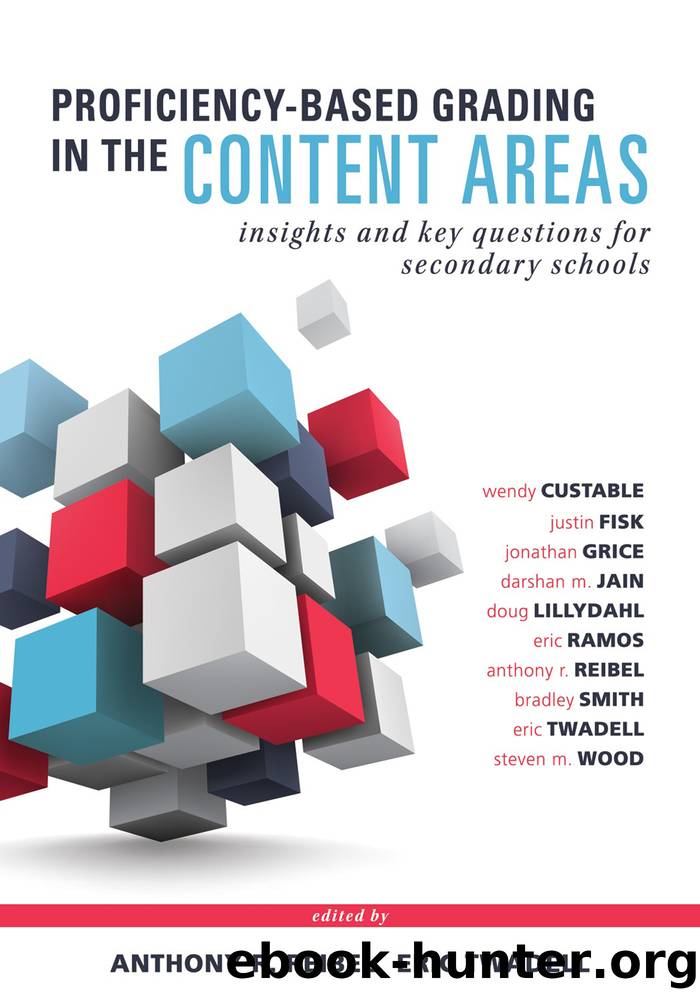Proficiency-Based Grading in the Content Areas by unknow

Author:unknow
Language: eng
Format: epub
Publisher: Solution Tree
Published: 2019-08-15T00:00:00+00:00
Once students establish the geometric and algebraic relationships, they observe that the points are colinear and sequenced as D, A, B, and C (relative to each other). The segment lengths of DA, AB, and BC are 10, 11, and 12, respectively. As such, A and B neither bisect nor trisect CD. A written explanation accessing definitions and algebraic work justifying evaluation of segment lengths would follow.
This exercise can be used formatively within instruction and provide opportunities for students to interact with the proficiency scale (or scaled learning targets). Figure 5.3 has two learning targets from the geometry example. The learning targets are scaled to form a gradation that represents the continuum of learning within that target.
Here, the teacher can guide students in self-assessment of their work. Through practice, feedback, and refinement, students can begin to locate their levels of learning on the scale. When used regularly in instruction, students begin to view scales not as instruments of judgment but as familiar tools that support and guide learning. If students are to reflect and grow their efficacy, then they must have experiences in class that teach them to identify their current proficiency level and build supportive pathways to close any gap to mastery.
Commitment 4: Apply a Consistent Proficiency Scale for Mathematics
Teachers must commit to maintaining a consistent proficiency scale throughout the learning. This consistency supports studentsâ work, reflection, and actions. Doing so establishes the scale as the same feedback instrument used regardless of changing contexts. If the proficiency gradation (the feedback instrument) changes from topic to topic or unit to unit, then students must learn not only new academic content but also a new assessment instrument.
Download
This site does not store any files on its server. We only index and link to content provided by other sites. Please contact the content providers to delete copyright contents if any and email us, we'll remove relevant links or contents immediately.
Macmillan Primary Grammar 2 Pupil's Book by Unknown(415)
Figuring Out Fluency in Mathematics Teaching and Learning, Grades K-8 by Jennifer M. Bay-Williams & John J. SanGiovanni(373)
The Principal's Guide to Curriculum Leadership by Sorenson Richard D.;Goldsmith Lloyd M.;Mendez Zulma Y.;Maxwell Karen T.;(296)
Learning from Accidents 3rd ed by Trevor Kletz (2001)(259)
English Grammar Practice--The Noun by Roxana Nastase(256)
Harnessing Technology for Deeper Learning by Scott McLeod(253)
Text-Dependent Questions, Grades K-5 by Douglas Fisher & Nancy Frey & Heather Anderson & Marisol Thayre(235)
A Guide to Curriculum Mapping by Hale Janet A.;(229)
How to Do Everything with Google Tools by Unknown(222)
English Language Program Administration by Unknown(221)
Deep Change Leadership by Reeves Douglas;(209)
The Grammar Teacher's Activity-a-Day by Jack Umstatter(205)
The Power of SMART Goals by Conzemius Anne;O'Neill Jan; & Anne Conzemius(194)
Beyond the RTI Pyramid by Bender William N.;(177)
Aligning and Balancing the Standards-Based Curriculum by Squires David A.;(175)
Functional Neuroradiology: Principles and Clinical Applications by Scott H. Faro (editor) Feroze B. Mohamed (editor)(173)
Using Data to Close the Achievement Gap by Johnson Ruth S.;(171)
Using Equity Audits to Create Equitable and Excellent Schools by Skrla Linda E.;McKenzie Kathryn B.;Scheurich James Joseph;(170)
Differentiated Instructional Strategies for the Block Schedule by Gregory Gayle H.;Herndon Lynne E.; & Lynne E. Herndon(167)
